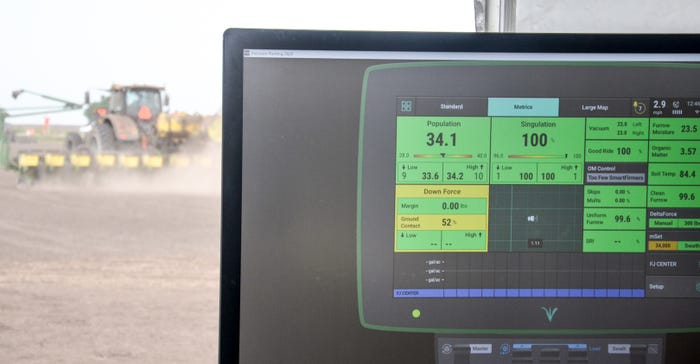
The best way to learn what new technology can do for you is try it on your own farm. The second-best way is to test-drive equipment, or ride along with someone else, on a demonstration farm. That was part of the inspiration behind the Precision Planting test farm near Pontiac, Ill. Jason Webster manages the farm and helps set up demonstrations for Precision Planting.
“We have lots of plots to test practices related to planting technology in the field,” Webster told visitors last summer. “But we also left about 30 acres so we farmers could drive or ride along with our equipment operators in demonstrations. We ran several different planter and tractor combinations in the field so people could get a feel for what various technologies can do.”
Late July and August were so dry at the farm that visitors sometimes encountered dusty conditions. That’s what it was like the day I visited. But it was still eye-opening to see equipment operate and get a chance to ride inside two tractor cabs, pulling planters equipped with different technology.
Virtual reality
Before venturing out to one of the tractors, I sat inside a tent at the edge of the field, watching a direct feed from the Precision Planting 20/20 monitors in tractor cabs pulling planters that other farmers were trying. The monitor’s feed was displayed on a large flat-screen TV.
Precision Planting is into its third generation of 20/20 monitors. Newer versions still display everything the original monitor screen displayed, but also make it easier to view information collected by Precision Planting SmartFirmer technology. Electronic eyes on seed firmers relay information on organic matter content, soil moisture, temperature and residue content in the furrow, plus more.
One interesting scenario developed as I watched the TV screen. It was displaying input from a planter with high-speed seed tubes. They’re designed to run at up to 10 miles per hour. The farmer behind the wheel decided to give the system a real test — taking it up to 16 miles per hour! Row units maintained ground contact, but singulation began to slip slightly. The Precision Planting technician noted that no one recommends planting at 16 miles per hour!
Watch planter display
My first ride was in a Massey Ferguson, complete with its own sophisticated display screen showing tractor operations that were being monitored live. The tractor was pulling a six-row mounted toolbar equipped with Precision Planting row units spaced on 20-inch rows.
Since this one didn’t have high-speed planting tubes, we kept to a civilized speed of just over 5 miles per hour. What caught my eye was that planter passes displayed on the 20/20 screen. As we skipped a pass or filled in where a pass hadn’t been made yet, it was easy to follow on the screen.
I also noticed that it marked multiples dropped by the units in tiny splotches of blue. The actual percentage of multiples was also displayed. Skips would have been in red, but virtually no red was showing up on our passes. The screen also displayed all the normal information about singulation and other planting parameters.
2nd ride
Next, I climbed aboard a Fendt tractor pulling a planter decked out with high-speed tubes and SmartFirmer. That’s the seed firmers with an electronic eye — signified by colored lights which display on the firmer when it’s working — that senses critical information in the furrow. Obviously, soil temperature was on the warm side and moisture content on the low side since we were planting on an early August day where it had rained very little for several weeks.
The twin 20/20 monitor displays caught my attention. The top screen was set to display the typical planting parameters, plus information from the SmartFirmer. The bottom screen displayed actual passes with the planter.
The Precision Planting technician driving the tractor flipped to the downforce display screen. The planter was also equipped with Precision Planting’s DeltaForce system, which controls the downforce on each row. It keeps down pressure within the desired range, even if soil conditions vary.
He tinkered with settings just to show me what happens if there is too little or too much downforce. Any changes immediately showed up as different colors on the screen.
My head was spinning by the time I departed for home. This equipment is light-years ahead of when I planted with a John Deere 694A planter with plates. Back then, I was lucky if the marker chains worked and flipped the right way when I turned.
That reminds me. We didn’t use markers at the field day. Autosteering and GPS guided tractors instead.
Click through the slideshow below to see photos from the field day.
About the Author(s)
You May Also Like




